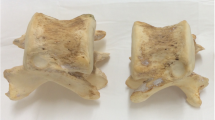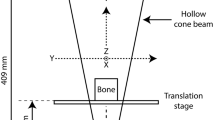Abstract
We studied the feasibility of cancellous bone structure assessment of the proximal femur using multidetector computed tomography (MDCT) in an simulated in vivo experimental model. The proximal femur of 15 intact human cadavers was examined using 64-row MDCT using a thin-section protocol with an in-plane spatial resolution of 273 μm. High-resolution peripheral quantitative computed tomography (HR-pQCT) of the isolated specimens with a voxel size of 82 μm served as a standard of reference. Trabecular bone structure and optimized textural parameters were calculated in MDCT images and compared to measures obtained by HR-pQCT. Significant correlations between MDCT- and HR-pQCT-derived values for bone fraction (r = 0.87), trabecular separation (r = 0.66), and number (r = 0.53) were found. Parameters derived from textural analysis performed better in predicting trabecular separation (up to r = 0.86) and number (up to r = 0.83). Trabecular thickness could not be quantified correctly using MDCT, most likely due to its limited resolution. Individual parameters for assessement of trabecular microarchitecture can be measured using MDCT-derived imaging studies and a simulated in vivo setup. Thus, in vivo assessment of bone architecture in addition to BMD may be feasible in clinical practice.




Similar content being viewed by others
References
Consensus Development Conference (1991) Prophylaxis and treatment of osteoporosis. Am J Med 90:107–110
Cummings SR, Nevitt MC, Browner WS et al (1995) Risk factors for hip fracture in white women. Study of Osteoporotic Fractures Research Group. N Engl J Med 332:767–773
Kanis JA, Borgstrom F, De Laet C et al (2005) Assessment of fracture risk. Osteoporos Int 16:581–589
Taylor BC, Schreiner PJ, Stone KL et al (2004) Long-term prediction of incident hip fracture risk in elderly white women: study of osteoporotic fractures. J Am Geriatr Soc 52:1479–1486
Mundinger A, Wiesmeier B, Dinkel E, Helwig A, Beck A, Schulte Moenting J (1993) Quantitative image analysis of vertebral body architecture—improved diagnosis in osteoporosis based on high-resolution computed tomography. Br J Radiol 66:209–213
Ammann P, Rizzoli R (2003) Bone strength and its determinants. Osteoporos Int 14(Suppl 3):S13–S18
Goldstein SA, Goulet R, McCubbrey D (1993) Measurement and significance of three-dimensional architecture to the mechanical integrity of trabecular bone. Calcif Tissue Int 53(Suppl 1):S127–S132
Mosekilde L (1993) Vertebral structure and strength in vivo and in vitro. Calcif Tissue Int 53(Suppl 1):S121–S126
Link TM, Majumdar S, Lin JC et al (1998) Assessment of trabecular structure using high resolution CT images and texture analysis. J Comput Assist Tomogr 22:15–24
Link TM, Majumdar S, Lin JC et al (1998) A comparative study of trabecular bone properties in the spine and femur using high resolution MRI and CT. J Bone Miner Res 13:122–132
Tabor Z, Rokita E (2007) Quantifying anisotropy of trabecular bone from gray-level images. Bone 40:966–972
Wigderowitz CA, Paterson CR, Dashti H, McGurty D, Rowley DI (2000) Prediction of bone strength from cancellous structure of the distal radius: can we improve on DXA? Osteoporos Int 11:840–846
Gordon CL, Lang TF, Augat P, Genant HK (1998) Image-based assessment of spinal trabecular bone structure from high-resolution CT images. Osteoporos Int 8:317–325
Ito M, Ikeda K, Nishiguchi M et al (2005) Multi-detector row CT imaging of vertebral microstructure for evaluation of fracture risk. J Bone Miner Res 20:1828–1836
Ito M, Ohki M, Hayashi K, Yamada M, Uetani M, Nakamura T (1997) Relationship of spinal fracture to bone density, textural, and anthropometric parameters. Calcif Tissue Int 60:240–244
Bauer JS, Issever AS, Fischbeck M et al (2004) Multislice-CT for structure analysis of trabecular bone—a comparison with micro-CT and biomechanical strength [in German]. Rofo 176:709–718
Issever AS, Vieth V, Lotter A et al (2002) Local differences in the trabecular bone structure of the proximal femur depicted with high-spatial-resolution MR imaging and multisection CT. Acad Radiol 9:1395–1406
Bauer JS, Kohlmann S, Eckstein F, Mueller D, Lochmuller EM, Link TM (2006) Structural analysis of trabecular bone of the proximal femur using multislice computed tomography: a comparison with dual X-ray absorptiometry for predicting biomechanical strength in vitro. Calcif Tissue Int 78:78–89
Link TM, Vieth V, Langenberg R et al (2003) Structure analysis of high resolution magnetic resonance imaging of the proximal femur: in vitro correlation with biomechanical strength and BMD. Calcif Tissue Int 72:156–165
Bauer JS, Link TM, Burghardt A et al (2007) Analysis of trabecular bone structure with multidetector spiral computed tomography in a simulated soft-tissue environment. Calcif Tissue Int 80:366–373
Boutroy S, Bouxsein ML, Munoz F, Delmas PD (2005) In vivo assessment of trabecular bone microarchitecture by high-resolution peripheral quantitative computed tomography. J Clin Endocrinol Metab 90:6508–6515
Laib A, Hildebrand T, Hauselmann HJ, Ruegsegger P (1997) Ridge number density: a new parameter for in vivo bone structure analysis. Bone 21:541–546
Muller R, Hildebrand T, Ruegsegger P (1994) Non-invasive bone biopsy: a new method to analyse and display the three-dimensional structure of trabecular bone. Phys Med Biol 39:145–164
Laib A, Ruegsegger P (1999) Calibration of trabecular bone structure measurements of in vivo three-dimensional peripheral quantitative computed tomography with 28-microm-resolution microcomputed tomography. Bone 24:35–39
Link TM, Majumdar S, Augat P et al (1998) In vivo high resolution MRI of the calcaneus: differences in trabecular structure in osteoporosis patients. J Bone Miner Res 13:1175–1182
Haralick RM, Shanmugam K, Dinstein I (1973) Textural features for image classification. EEE Trans Syst Man Cybernet 3:610–621
Anys H, He C (1995) Evaluation of textural and multipolarization radar features for crop classification. IEEE 33:1170–1181
Jiang C, Pitt RE, Bertram JE, Aneshansley DJ (1999) Fractal-based image texture analysis of trabecular bone architecture. Med Biol Eng Comput 37:413–418
Boehm H, Link T, Monetti R (2006) Analysis of the topological properties of the proximal femur on a regional scale: evaluation of multi-detector CT-scans for the assessment of biomechanical strength using local Minkowski functionals in 3D. In: SPIE Medical Imaging. San Diego, pp 6144–6254
Boehm HF, Raeth C, Monetti RA et al (2003) Local 3D scaling properties for the analysis of trabecular bone extracted from high-resolution magnetic resonance imaging of human trabecular bone: comparison with bone mineral density in the prediction of biomechanical strength in vitro. Invest Radiol 38:269–280
Wachter NJ, Augat P, Mentzel M et al (2001) Predictive value of bone mineral density and morphology determined by peripheral quantitative computed tomography for cancellous bone strength of the proximal femur. Bone 28:133–139
Link TM, Vieth V, Stehling C et al (2003) High-resolution MRI vs multislice spiral CT: which technique depicts the trabecular bone structure best? Eur Radiol 13:663–671
Cortet B, Chappard D, Boutry N, Dubois P, Cotten A, Marchandise X (2004) Relationship between computed tomographic image analysis and histomorphometry for microarchitectural characterization of human calcaneus. Calcif Tissue Int 75:23–31
Patel PV, Prevrhal S, Bauer JS et al (2005) Trabecular bone structure obtained from multislice spiral computed tomography of the calcaneus predicts osteoporotic vertebral deformities. J Comput Assist Tomogr 29:246–253
Graeff C, Timm W, Nickelsen TN et al (2007) Monitoring teriparatide-associated changes in vertebral microstructure by high-resolution CT in vivo: results from the EUROFORS study. J Bone Miner Res 22:1426–1433
Hipp JA, Jansujwicz A, Simmons CA, Snyder BD (1996) Trabecular bone morphology from micro-magnetic resonance imaging. J Bone Miner Res 11:286–297
Vieth V, Link TM, Lotter A et al (2001) Does the trabecular bone structure depicted by high-resolution MRI of the calcaneus reflect the true bone structure? Invest Radiol 36:210–217
Kazakia GJ, Hyun B, Burghardt AJ et al (2008) In vivo determination of bone structure in postmenopausal women: a comparison of HR-pQCT and high-field MR imaging. J Bone Miner Res 23:463–474
Krug R, Carballido-Gamio J, Banerjee S, Burghardt AJ, Link TM, Majumdar S (2008) In vivo ultra-high-field magnetic resonance imaging of trabecular bone microarchitecture at 7 T. J Magn Reson Imaging 27:854–859
Eckstein F, Lochmuller EM, Lill CA et al (2002) Bone strength at clinically relevant sites displays substantial heterogeneity and is best predicted from site-specific bone densitometry. J Bone Miner Res 17:162–171
Muller R, Koller B, Hildebrand T et al (1996) Resolution dependency of microstructural properties of cancellous bone based on three-dimensional mu-tomography. Technol Health Care 4:113–119
MacNeil JA, Boyd SK (2007) Accuracy of high-resolution peripheral quantitative computed tomography for measurement of bone quality. Med Eng Phys 29:1096–1105
Author information
Authors and Affiliations
Corresponding author
Rights and permissions
About this article
Cite this article
Diederichs, G., Link, T., Marie, K. et al. Feasibility of Measuring Trabecular Bone Structure of the Proximal Femur Using 64-Slice Multidetector Computed Tomography in a Clinical Setting. Calcif Tissue Int 83, 332–341 (2008). https://doi.org/10.1007/s00223-008-9181-y
Received:
Accepted:
Published:
Issue Date:
DOI: https://doi.org/10.1007/s00223-008-9181-y




